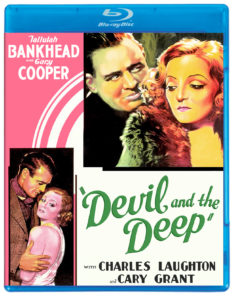Pre-code Submarine Drama Stars Gary Cooper, Tallulah Bankhead, Cary Grant, and Introduces Charles Laughton.
DIRECTED BY MARION GERING/1932
BLU-RAY STREET DATE: OCTOBER 26, 2021/KL STUDIO CLASSICS

Part submarine picture, part hopeless love triangle drama, 1932’s Devil and the Deep manages to sink to new lows while never giving up the ship. By the doom-laden climax of the film, the key cast is submerged in a sunken sub on the ocean floor. The rivets are a’poppin’ and the water is a’risin’…. It’s the perfect time for a cheating wife and her upstanding lover to confront her despicable husband, who also happens to be the commander that got them into this pending watery grave.
Though Devil and the Deep has a number of things going for it, some aspects are more prominent than others. As is the case with any movie that has Charles Laughton, Charles Laughton is the main attraction. Devil and the Deep bears the distinction of being the great scene stealer’s first film outing- released prior to Universal’s The Old Dark House, in which Laughton actually acted on film first.
As was so often the case, Laughton is the heavy. In this case, he is, as film historian David Del Valle articulates on his new audio commentary track, an “uptight naval commander teetering on the brink of insanity”. His wife, played with viable slank but also in vulnerable fashion by Tallulah Bankhead, is the immediate source of said insanity. A pre-code glamour-puss of Dietrich-ian proportions (not to mention expression), Bankhead finds herself at the center of Devil and the Deep playing the Victimized Cheater.
The sentiment soon surfaces that her dalliances ought to be entirely forgivable, as her husband is nothing but a domineering monster. She swaps an up-and-coming Cary Grant for a tall, proud, and well-festooned officer played by Gary Cooper. Laughton, jealous as all hell, is never far behind her. First he identifies his younger upgrade, then he moves to destroy him. In terms of Grant, it appears only be his career might be destroyed. By the time Laughton gets Cooper in his crosshairs, he’s trying to physically destroy him. Anyone else in the vicinity will simply be collateral damage.

Kino Lorber Studio Classics’ inaugural Blu-ray release of Devil and the Deep is, for pre-code fans and fans of the talent involved, worth the wait. The post-Morocco austere lavishness of so many Paramount films of this era is vividly on display, and the black and white cinematography looks rightly lush. (The various naval vessels, however, can’t help looking like detailed models in a studio tub). Though Marion Gering’s directorial style is neither here nor there, the performances land as they ought. David Del Valle’s commentary- the only extra feature aside from trailers- is truly excellent. Del Valle is a pleasure to stick with as he goes through the film and details main aspects, avoiding tangents and filler.
If Laughton is the gravity-emitting center, and, as Del Valle correctly assesses, Bankhead is the heart, then where does that leave Cooper? (Grant is an on-and-gone smaller role). Strictly in the realm of “just fine”, that’s where. Keep in mind that this is 1932, and Gary Cooper is not all that far ahead of someone like Cary Grant in terms of cultivating an enduring leading man persona and status. Director Gering correctly channels Cooper’s inherent goodness into his character, the lieutenant serving directly beneath Laughton. But aside from Cooper’s admittedly indomitable quality, the actor, in this film, can read as the most all-American block of wood to find itself fully submerged. Look closely and you’ll see that that’s not quite true. (Cooper had a mystical way with a camera lens, something that only intensified as he got older). But then again, Devil and the Deep isn’t a film that demands a closer look.
Which is to say that despite the film’s stellar cast (which reads far more stellar now than it did at the time), it, like Cooper’s performance, rates as “just fine”. Up until this Blu-ray release, Devil and the Deep hasn’t been particularly easy to see. On star-power alone, it ranks as a pre-code treasure of a sort. It bears a poignant early-1930s opulence right up to when everyone (even Ms. Bankhead) finds themselves bottled up together on the submarine. The situation and subsequent conundrum make for good suspense, if not a believable resolution. But, it’s good enough. Or, “just fine”… even as, by design, it sinks to the bottom- in model fashion.

